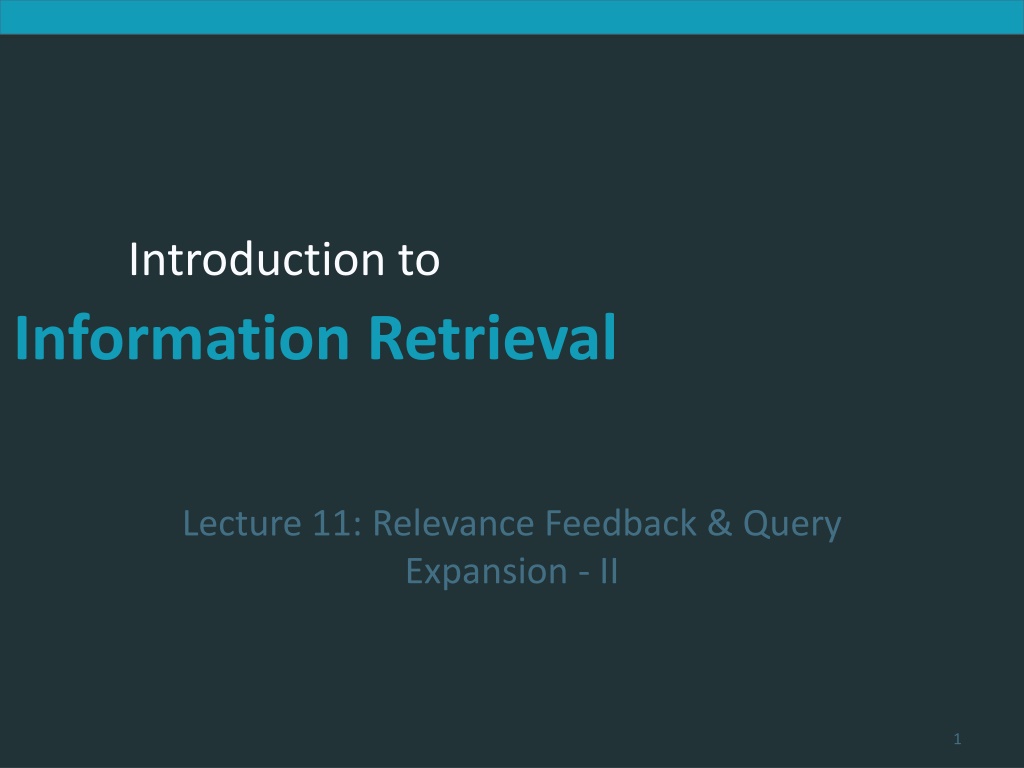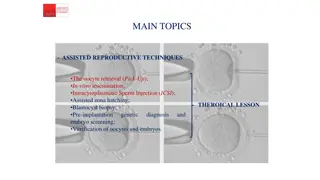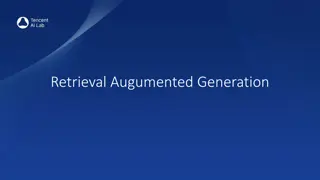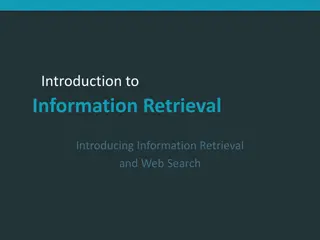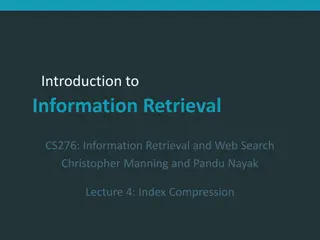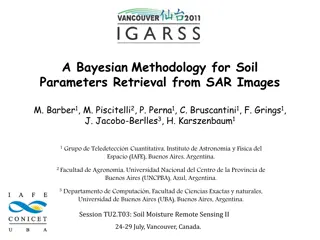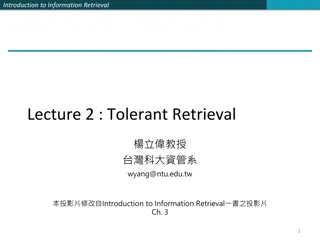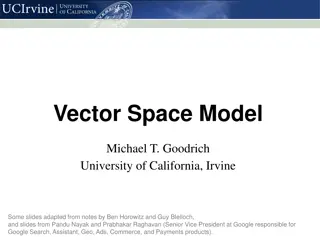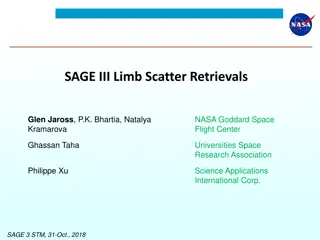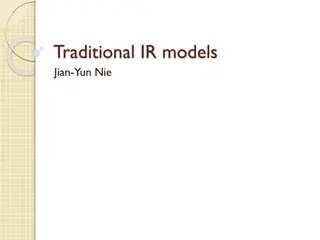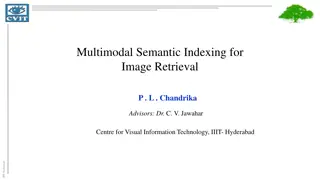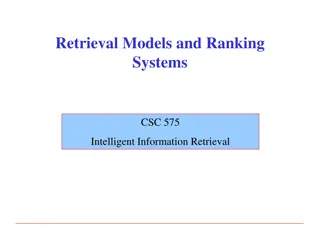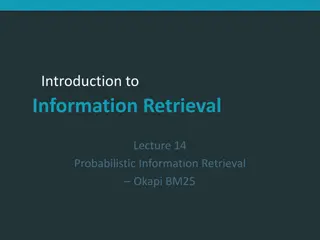Information Retrieval
Behavior therapies involve applying learning principles to modify maladaptive behaviors. Techniques such as systematic desensitization, aversion therapy, social skills training, and biofeedback are utilized to address various psychological disorders. Evaluating therapeutic outcomes is crucial in assessing the effectiveness of behavior therapies, which are beneficial for treating conditions like phobias, OCD, schizophrenia, and more.
Download Presentation

Please find below an Image/Link to download the presentation.
The content on the website is provided AS IS for your information and personal use only. It may not be sold, licensed, or shared on other websites without obtaining consent from the author. Download presentation by click this link. If you encounter any issues during the download, it is possible that the publisher has removed the file from their server.
E N D
Presentation Transcript
Introduction to Information Retrieval Introduction to Information Retrieval Lecture 11: Relevance Feedback & Query Expansion - II 1
Introduction to Information Retrieval Take-away today Interactive relevance feedback: improve initial retrieval results by telling the IR system which docs are relevant / nonrelevant Best known relevance feedback method: Rocchio feedback Query expansion: improve retrieval results by adding synonyms / related terms to the query Sources for related terms: Manual thesauri, automatic thesauri, query logs 2 2
Introduction to Information Retrieval Rocchio 1971 algorithm (SMART) Used in practice: qm: modified query vector; q0: original query vector; Drand Dnr : sets of known relevant and nonrelevant documents respectively; , , and : weights New query moves towards relevant documents and away from nonrelevant documents. Tradeoff vs. / : If we have a lot of judged documents, we want a higher / . Set negative term weights to 0. Negative weight for a term doesn t make sense in the vector space model. 3 3
Introduction to Information Retrieval Positive vs. negative relevance feedback Positive feedback is more valuable than negative feedback. For example, set = 0.75, = 0.25 to give higher weight to positive feedback. Many systems only allow positive feedback. 4 4
Introduction to Information Retrieval Relevance feedback: Assumptions When can relevance feedback enhance recall? Assumption A1: The user knows the terms in the collection well enough for an initial query. Assumption A2: Relevant documents contain similar terms (so I can hop from one relevant document to a different one when giving relevance feedback). 5 5
Introduction to Information Retrieval Violation of A1 Assumption A1: The user knows the terms in the collection well enough for an initial query. Violation: Mismatch of searcher s vocabulary and collection vocabulary Example: cosmonaut / astronaut 6 6
Introduction to Information Retrieval Violation of A2 Assumption A2: Relevant documents are similar. Example for violation: [contradictory government policies] Several unrelated prototypes Subsidies for tobacco farmers vs. anti-smoking campaigns Aid for developing countries vs. high tariffs on imports from developing countries Relevance feedback on tobacco docs will not help with finding docs on developing countries. 7 7
Introduction to Information Retrieval Relevance feedback: Evaluation Pick one of the evaluation measures from last lecture, e.g., precision in top 10: P@10 Compute P@10 for original query q0 Compute P@10 for modified relevance feedback query q1 In most cases: q1 is spectacularly better than q0! Is this a fair evaluation? 8 8
Introduction to Information Retrieval Evaluation: Caveat True evaluation of usefulness must compare to other methods taking the same amount of time. Alternative to relevance feedback: User revises and resubmits query. Users may prefer revision/resubmission to having to judge relevance of documents. There is no clear evidence that relevance feedback is the best use of the user s time. 9 9
Introduction to Information Retrieval Relevance feedback: Problems Relevance feedback is expensive. Relevance feedback creates long modified queries. Long queries are expensive to process. Users are reluctant to provide explicit feedback. It s often hard to understand why a particular document was retrieved after applying relevance feedback. The search engine Excite had full relevance feedback at one point, but abandoned it later. 10 10
Introduction to Information Retrieval Pseudo-relevance feedback Pseudo-relevance feedback automates the manual part of true relevance feedback. Pseudo-relevance algorithm: Retrieve a ranked list of hits for the user s query Assume that the top k documents are relevant. Do relevance feedback (e.g., Rocchio) Works very well on average But can go horribly wrong for some queries. Several iterations can cause query drift. 11 11
Introduction to Information Retrieval Pseudo-relevance feedback at TREC4 Cornell SMART system Results show number of relevant documents out of top 100 for 50 queries (so total number of documents is 5000): method number of relevant documents lnc.ltc 3210 lnc.ltc-PsRF 3634 Lnu.ltu 3709 Lnu.ltu-PsRF 4350 Results contrast two length normalization schemes (L vs. l) and pseudo-relevance feedback (PsRF). The pseudo-relevance feedback method used added only 20 terms to the query. (Rocchio will add many more.) This demonstrates that pseudo-relevance feedback is effective on average. 12 12
Introduction to Information Retrieval Outline Motivation Relevance feedback: Basics Relevance feedback: Details Query expansion 13
Introduction to Information Retrieval Query expansion Query expansion is another method for increasing recall. We use global query expansion to refer to global methods for query reformulation . In global query expansion, the query is modified based on some global resource, i.e. a resource that is not query- dependent. Main information we use: (near-)synonymy A publication or database that collects (near-)synonyms is called a thesaurus. We will look at two types of thesauri: manually created and automatically created. 14 14
Introduction to Information Retrieval Query expansion: Example 15 15
Introduction to Information Retrieval Types of user feedback User gives feedback on documents. More common in relevance feedback User gives feedback on words or phrases. More common in query expansion 16 16
Introduction to Information Retrieval Types of query expansion Manual thesaurus (maintained by editors, e.g., PubMed) Automatically derived thesaurus (e.g., based on co- occurrence statistics) Query-equivalence based on query log mining (common on the web as in the palm example) 17 17
Introduction to Information Retrieval Thesaurus-based query expansion For each term t in the query, expand the query with words the thesaurus lists as semantically related with t. Example from earlier: HOSPITAL MEDICAL Generally increases recall May significantly decrease precision, particularly with ambiguous terms INTEREST RATE INTEREST RATE FASCINATE Widely used in specialized search engines for science and engineering It s very expensive to create a manual thesaurus and to maintain it over time. A manual thesaurus has an effect roughly equivalent to annotation with a controlled vocabulary. 18 18
Introduction to Information Retrieval Automatic thesaurus generation Attempt to generate a thesaurus automatically by analyzing the distribution of words in documents Fundamental notion: similarity between two words Definition 1: Two words are similar if they co-occur with similar words. car motorcycle because both occur with road , gas and license , so they must be similar. Definition 2: Two words are similar if they occur in a given grammatical relation with the same words. You can harvest, peel, eat, prepare, etc. apples and pears, so apples and pears must be similar. Co-occurrence is more robust, grammatical relations are more accurate. 19 19
Introduction to Information Retrieval Co-occurence-based thesaurus: Examples 20 20
Introduction to Information Retrieval Query Expansion: Examples Query Expansion: Examples 21
Introduction to Information Retrieval Query expansion at search engines Main source of query expansion at search engines: query logs Example 1: After issuing the query [herbs], users frequently search for [herbal remedies]. herbal remedies is potential expansion of herb . Example 2: Users searching for [flower pix] frequently click on the URL photobucket.com/flower. Users searching for [flower clipart] frequently click on the same URL. flower clipart and flower pix are potential expansions of each other. 22 22
